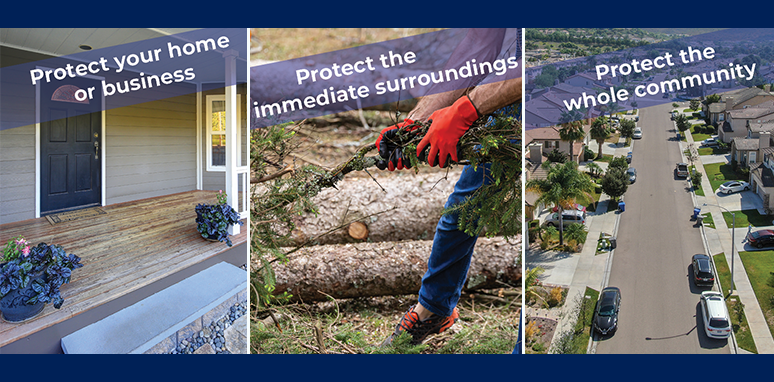Safer from Wildfires
Being Safer from Wildfires can help with your insurance

Safer from Wildfires is a ground-up approach to wildfire resilience with three layers of protection — for the structure, the immediate surroundings, and the community. Following these achievable steps can help you save money on your insurance. Safer from Wildfires was created by an interagency partnership between Insurance Commissioner Ricardo Lara and the emergency response and readiness agencies in Governor Gavin Newsom's administration.
-
Download a summary of Safer from Wildfires (English, PDF)
-
Download a summary of Safer from Wildfires (Spanish, PDF)
-
Download a summary of Safer from Wildfires (Mandarin, PDF)
Learn the 10 steps to being Safer from Wildfires
Every action under Safer from Wildfires will qualify you for an insurance discount. By doing more, you can save more. Read the full text of the new Safer from Wildfires insurance regulation.
-
Class-A fire rated roof – Most roofs qualify including asphalt shingles, concrete, brick, or masonry tiles, and metal shingles or sheets. Wood shake shingles are not Class A fire-resistant rated.The Office of the State Fire Marshal maintains a list of tested and approved materials.
-
5 foot ember resistant zone, including fencing – Removing greenery and replacing wood chips with stone or decomposed granite 5 feet around your home prevents fire from getting a foot in the door. Replacing wood fencing connecting to your home with metal is critical because it can act like a candle wick leading fire straight to your home.
-
Ember- and fire-resistant vents – Installing 1/16 to 1/8 inch noncombustible, corrosion-resistant metal mesh screens over exterior vents can keep wind-blown embers out of your house.
-
Non-combustible 6 inches at the bottom of exterior walls – Having a minimum of 6 vertical inches measured from the ground up and from any attached horizontal surface like a deck can stop embers from accumulating and igniting your walls. Noncombustible materials include brick, stone, fiber-cement siding or concrete.
-
Enclosed eaves – Installing soffits under your eaves can prevent heat and embers from getting trapped and igniting. When enclosing eaves, non-combustible or ignition resistant materials are recommended.
-
Upgraded windows – Multi-paned windows are more resistant to breaking during a wildfire, which helps keep flames from entering. Multi-paned glass or added shutters all qualify.
-
Cleared vegetation, weeds and debris from under decks – Noncombustible materials like concrete, gravel, or bare soil are permitted.
-
Removal of combustible sheds and other outbuildings to at least a distance of 30 feet – These include sheds, gazebos, accessory dwelling units (ADUs), open covered structures with a solid roof, dog houses and playhouses.
-
Defensible space compliance – following state and local laws requiring defensible space including trimming trees and removal of brush and debris from yard. See CAL FIRE’s defensible space page and your local city or county for details.
-
Being safer together – Safer from Wildfires recognizes two community-wide programs, Firewise USA and Fire Risk Reduction Communities as small as 8 dwelling units or as big as 2,500 can create an action plan and start being safer together. Firewise USA is a nationally recognized program with proven results, sponsored by the National Fire Prevention Association.
-
Learn how to Start a Firewise Community
Fire Risk Reduction Communities are local agencies located in a state responsibility area or a very high fire hazard severity zone that meet best practices for local fire planning. Fire Risk Reduction Communities are certified by the California Board of Forestry and Fire Protection.
- Wildfire Mitigation Partnership Summary can be downloaded
- View the full text of the Safer from Wildfires regulation here.






